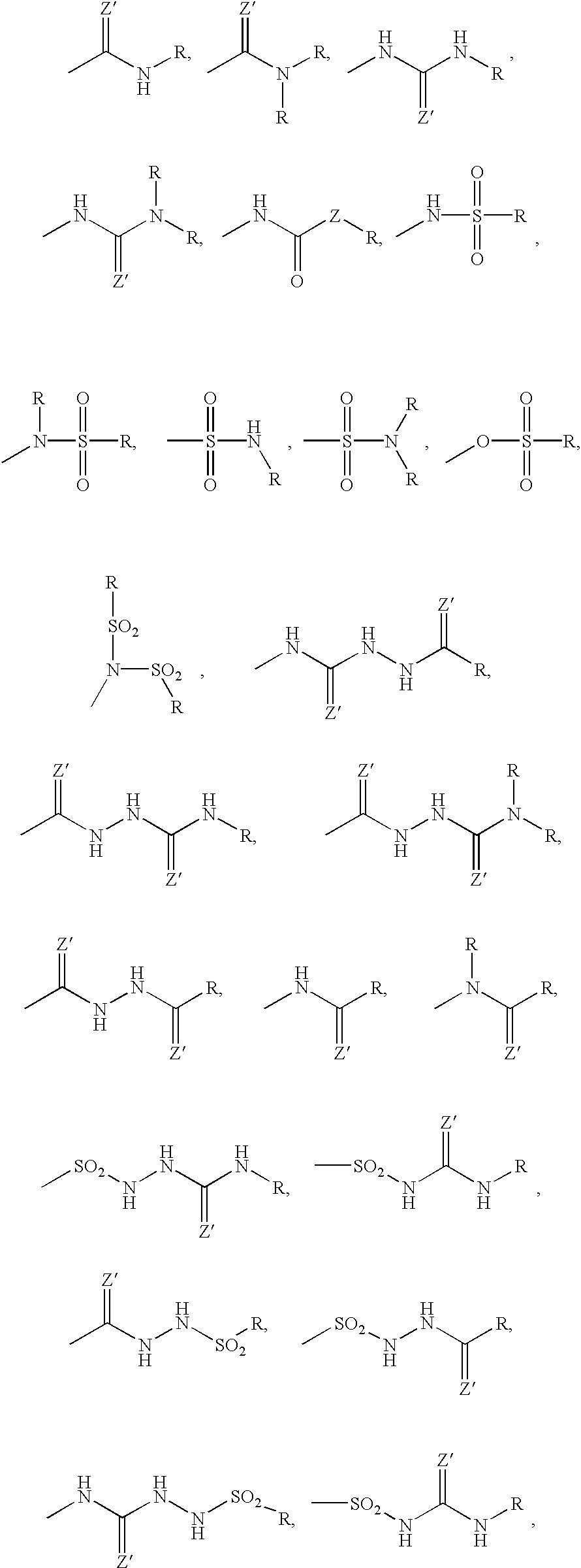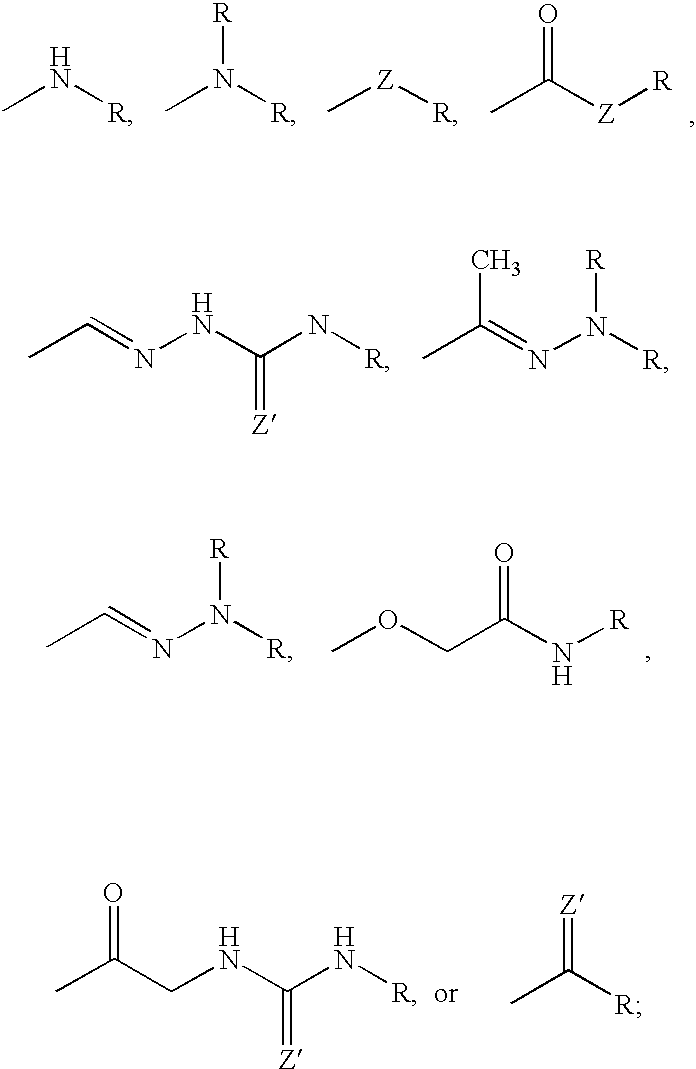Bisubstituted carbocyclic cyclophilin binding compounds and their use
a carbocyclic cyclophilin and binding compound technology, applied in the field of non-peptidic small molecule compounds, can solve the problems of poor penetration into the central nervous system, lack of appreciation of the usefulness of cyclophilin-binding compounds for treating disease states, injuries and other abnormal conditions involving the central nervous system and other parts of the body,
- Summary
- Abstract
- Description
- Claims
- Application Information
AI Technical Summary
Benefits of technology
Problems solved by technology
Method used
Image
Examples
example 1
[0238] Compounds containing N-sulfonyl linkages may be prepared according to the general method of Scheme I.
[0239] Preparation of [(3,5-dichlorophenyl)amino]-N-(3-{[(4-methoxylihenyl- )sulfonyl][(4-methylphenyl)sulfonyl]amino}phenyl)formamide (Compound 1): 38
[0240] N-(3-{[(4-methoxyphenyl)sulfonyl][4-methylphenyl)sulfonyl]-3-nitroa- niline. A solution of 3-nitroaniline (2 mmol), triethylamine (2 mmol), 4-methyphenyl sulfonyl chloride (2 mmol), and 4-methoxyphenylsulfonyl chloride (2 mmol) in dimethylacetamide (5 ml) was stirred at room temperature overnight. The reaction mixture was poured into ice-water, filtered, and the solid collected was recrystallized to obtain the title compound.
[0241] N-(3-{[(4-methoxyphenyl)sulfonyl][4-methylphenyl)sulfonyl]-1,3-diam- inobenze and conversion to [(3,5-dichlorophenyl)amino]-N-(3-{[(4-methoxyph- enyl) sulfonyl][(4-methylphenyl)sulfonyl]amino}phenyl)formamide. A mixture of the nitro compound (700 mg) and indium metal (3 g) in 15 mL of ethanol+4...
example 2
[0243] Preparation of (3,5-Dichlorophenyl)-N-(3-{[(4-methoxyphenyl)sulfony- l][(4-methylphenyl)sulfonyl]amino}phenyl)formamide (Compound 3).
[0244] A mixture of N-(3-{[(4-methoxyphenyl)sulfonyl][4-methylphenyl)sulfo- nyl]-1,3-diaminobenze, prepared as described above, 170 mg, in 4 mL of dimethylacetamide, was treated with triethylamine (1 mmol) and 3,5-dichloro-benzoyl chloride (0.5 mmol). The reaction mixture was stirred at room temperature overnight and then poured into ice water. The crude solid collected upon filtration was dissolved in acetonitrile and chromatographed by HPLC, using a gradient elution from 5% water / 95% acetonitrile with 0.1% TFA, to 100% acetonitrile with 0.1% TFA, to obtain compound 3 as a yellow solid, .sup.1H NMR (DMSO-d.sub.6, 400 MHz) .delta. 2.48(s, 3H); 3.92(s, 3H); 6.66(d, 1H); 7.18(d, 2H); 7.34(t, 1H); 7.48(d, 2H); 7.67(t, 1H); 7.8(m, 5H); 8.05(m, 3H); 10.53(s, 1H). Anal: Calcd for: C, 53.56; H, 3.66; N, 4.63; S, 10.59. Found: C, 53.71; H, 3.84; N, 4.60...
example 3
[0245] Preparation of (3-{bis[(3,5-dichlorophenyl)sulfonyl]amino}phenyl)[(- 4-methoxy-phenyl)sulfonyl][(4-methylphenyl)sulfonyl]amine (Compound 4). A mixture of N-(3-{[(4-methoxyphenyl)sulfonyl][4-methylphenyl)sulfonyl]-1,3- -diaminobenze, prepared as described above, 170 mg, in 4 mL of dimethylacetamide, was treated with triethylamine (1 mmol) and 3,5-dichlorosulfonyl chloride (0.5 mmol).). The reaction mixture was stirred at room temperature overnight and then poured into ice water. The crude solid collected upon filtration was dissolved in acetonitrile and chromatographed by HPLC, using a gradient elution from 5% water / 95% acetonitrile with 0.1% TFA, to 100% acetonitrile with 0.1% TFA, to obtain Compound 4 as a white solid, .sup.1H NMR (DMSO-d.sub.6, 400 MHz) .delta. 2.45(s, 3H); 3.91(s, 3H); 6.8(t, 1H); 7.15(d, 2H); 7.26(d, 1H); 7.4(d, 1H); 7.43(d, 2H); 7.58(t, 1H); 7.75(q, 4H); 7.85(d, 4H); 8.11(t, 2H). Anal.: Calc'd for: C, 45.42; H, 3; N, 3.21; S, 14.70. Found: C, 45.91; H, 3...
PUM
| Property | Measurement | Unit |
|---|---|---|
| Composition | aaaaa | aaaaa |
| Cell death | aaaaa | aaaaa |
| Permeability | aaaaa | aaaaa |
Abstract
Description
Claims
Application Information
 Login to View More
Login to View More - R&D
- Intellectual Property
- Life Sciences
- Materials
- Tech Scout
- Unparalleled Data Quality
- Higher Quality Content
- 60% Fewer Hallucinations
Browse by: Latest US Patents, China's latest patents, Technical Efficacy Thesaurus, Application Domain, Technology Topic, Popular Technical Reports.
© 2025 PatSnap. All rights reserved.Legal|Privacy policy|Modern Slavery Act Transparency Statement|Sitemap|About US| Contact US: help@patsnap.com



